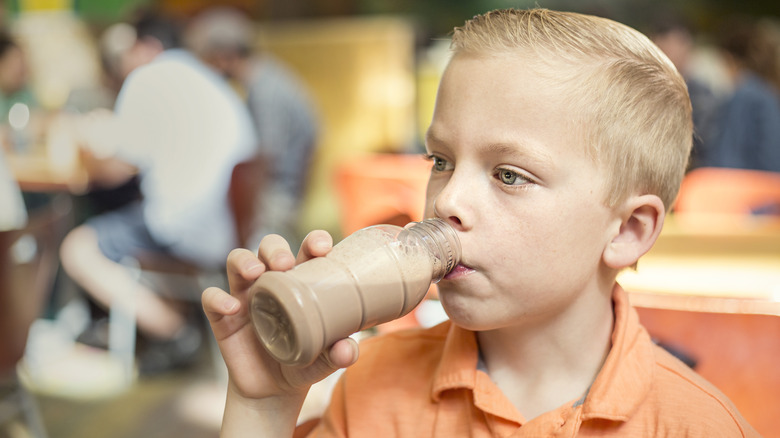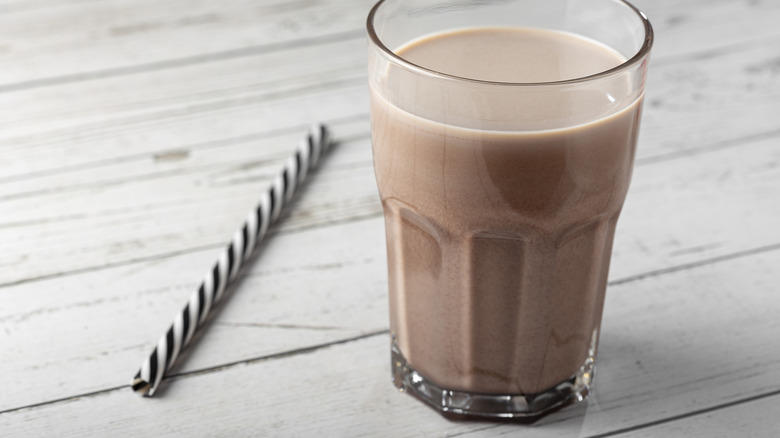The USDA May Ban Chocolate Milk In Middle And Elementary Schools
The USDA is considering a proposal that would effectively ban chocolate milk from elementary and middle school cafeterias nationwide. In high schools, it would be allowed, but limited. Cindy Long, the Food and Nutrition Service Administrator of the USDA, told The Wall Street Journal that "flavored milk is a challenging issue to figure out exactly the best path forward." The fact that chocolate milk could emerge as a contentious issue might seem almost comical to some consumers. But, others are taking it very seriously – including, apparently, the USDA itself.
The ban would reportedly be part of a long-term plan to "reduce children's risk of chronic disease," per the proposal via the Federal Register. It's no secret that consuming too many added sugars can increase the risk of developing cancer, heart problems, and insulin resistance, among other concerns. According to the American Diabetes Association, an estimated 283,000 Americans under the age of 20 have been diagnosed with diabetes. The CDC says that the number of people in that age group who have type 2 diabetes increased by 4.8% each year from 2002 to 2015. This is exactly the kind of issue that the USDA says it could try to curb by limiting sugar early on so that youngsters can grow into adults with nutritious eating habits ingrained.
Excess sugar consumption a budding epidemic
The New York City Center for Health warns that over the course of a week, a child can consume 80 grams of added sugar just by drinking chocolate milk two times a day. According to the CDC, children aged 2-19 consumed an average of 15-18 teaspoons of added sugar every day in 2017-2018. For reference, the American Heart Association recommends 6-9 for adults. Consequently, government officials are looking to identify areas where the figure can be reduced – which means flavored milk is on the chopping block. However, many parents and families argue that witch-hunting chocolate milk is not the place to start.
It may be difficult to ascertain the real potential of this proposal while it remains in its infancy. Michelle Obama's push for school lunch reform garnered major backlash from seemingly everybody old enough to have an opinion during the 2010s, but a 2020 study suggested the 2010 Healthy Hunger-Free Kids Act that Obama advocated, improved the nutrition of school lunches, particularly in lower-income areas.
But the USDA isn't alone in wanting to address excess sugar intake. Last month, the International Dairy Foods Association published a "Healthy School Milk Commitment," pledging to include no more than 10 grams of sugar per eight fluid ounces of milk, flavoring included. Effectively, what the IDAF is pitching is reduced sugar, low-calorie chocolate milk: A happy medium solution. 37 milk manufacturers encompassing all 50 states and Puerto Rico have already signed the pledge.
Not everyone thinks axing chocolate milk is the answer
Now, when it comes to dealing with this new matter of to-flavor or not-to-flavor, some experts are encouraging a more "realistic" approach. Per the Federal Register, 86-ing chocolate milk in schools would "promote the more nutrient-dense choice of unflavored milk for young children when their tastes are being formed." But, as New England Dairy Director of Youth Wellness Erin Wholey points out, via CBS News, most kids aren't exactly lining up for a glass of plain milk.
The flavor part is important for getting developing youngsters to enjoy drinking nutrient-dense milk and consuming the calcium, vitamin D, and potassium they need, according to says Wholey. An outright ban might cut down on added sugar intake but, in doing so, it has the potential to cut down on the intake of essential nutrients, as well. The FDA is anticipated to announce a definitive ruling in time for the 2024-2025 school year.


